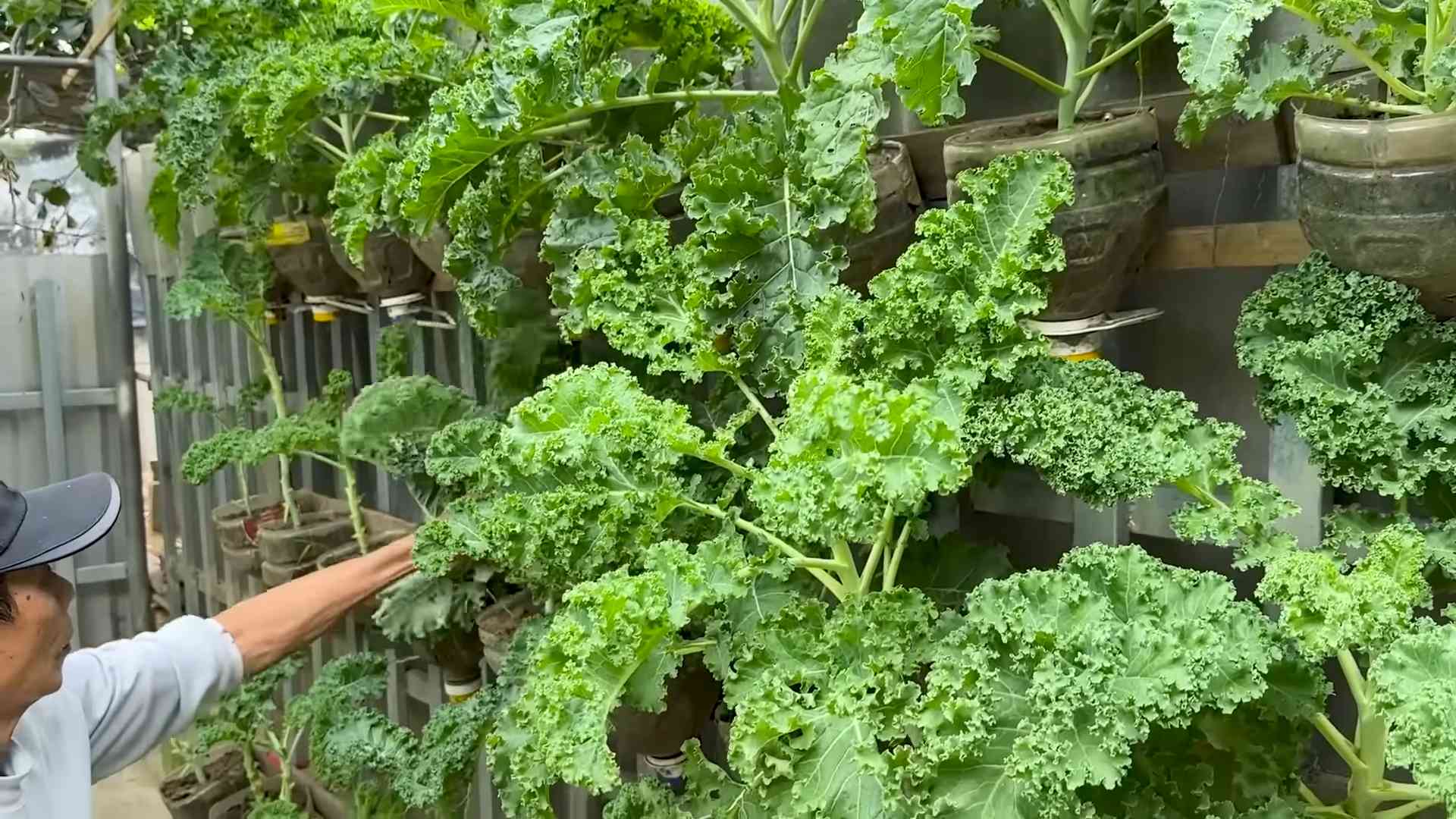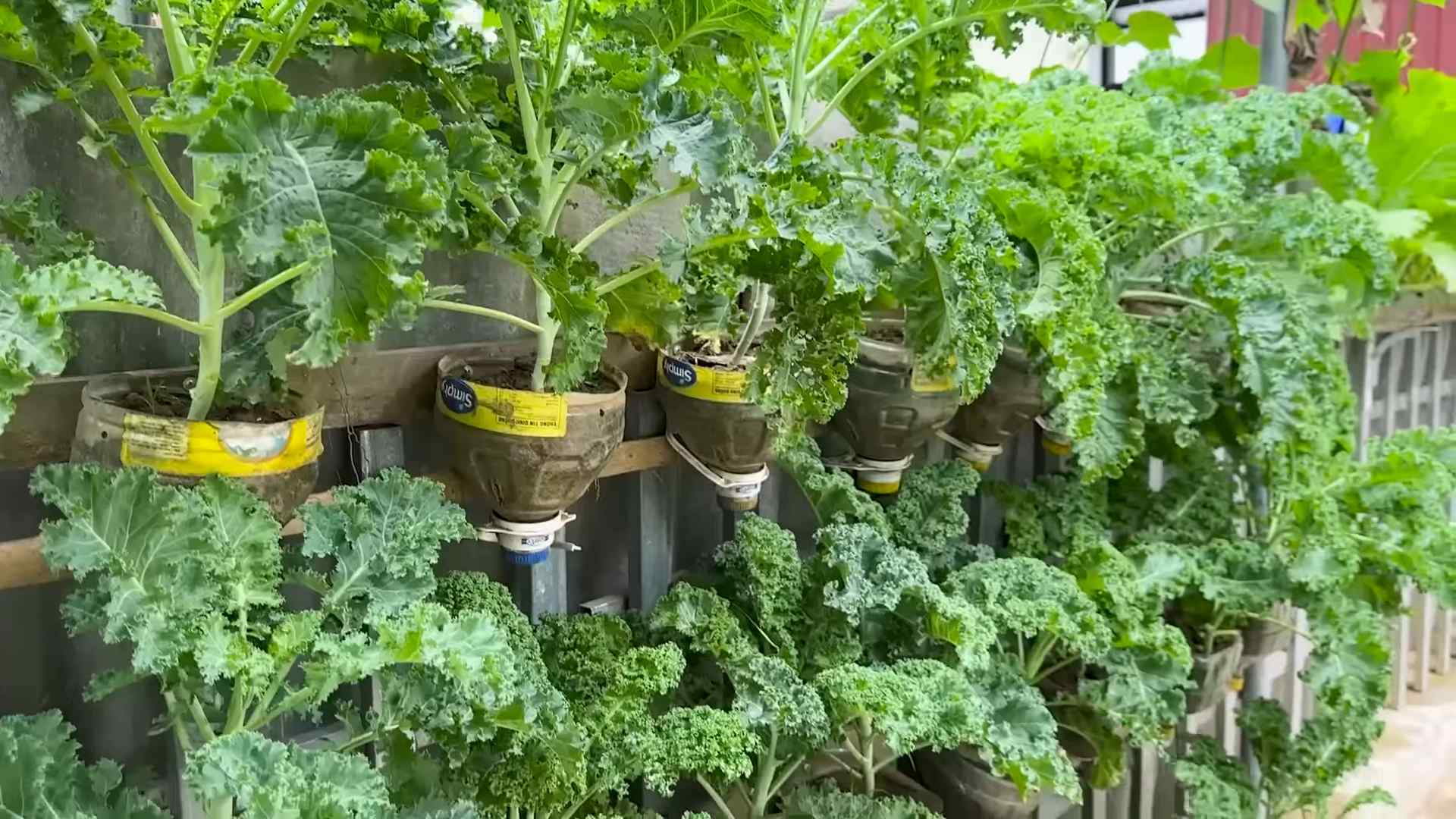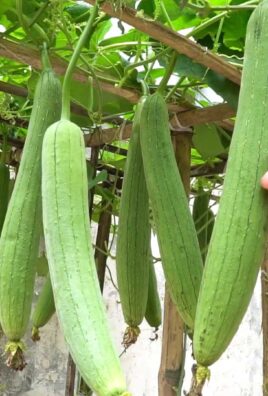Growing Kale at Home can seem daunting, especially if you’re new to gardening. But trust me, with a few simple tricks and a little DIY spirit, you can be harvesting your own delicious and nutritious kale in no time! Forget those wilted, overpriced bunches at the grocery store. Imagine stepping out into your backyard or even onto your balcony and picking fresh, vibrant kale leaves for your salads, smoothies, or stir-fries.
Kale has a rich history, dating back to ancient Greece and Rome, where it was a staple food. Over the centuries, it has spread across the globe, becoming a beloved vegetable in countless cuisines. Its resilience and nutritional value have made it a favorite among gardeners and health enthusiasts alike.
Why should you bother with this DIY project? Well, for starters, growing kale at home is incredibly rewarding. There’s nothing quite like the satisfaction of nurturing a plant from seed to harvest. Plus, you’ll know exactly what’s going into your food – no harmful pesticides or chemicals. And let’s be honest, saving money on groceries is always a win! This article will provide you with easy-to-follow tips and tricks to ensure your kale thrives, even if you have limited space or experience. So, grab your gardening gloves, and let’s get started!

Growing Kale at Home: A Beginner’s Guide
Hey there, fellow gardening enthusiasts! I’m so excited to share my experience with growing kale at home. It’s surprisingly easy, incredibly rewarding, and gives you access to fresh, nutritious greens right in your backyard (or even on your balcony!). Kale is a superfood powerhouse, packed with vitamins and minerals, and it’s incredibly versatile in the kitchen. So, let’s dive in and get our hands dirty!
Choosing Your Kale Variety
Before we even think about planting, we need to decide what kind of kale we want to grow. There are several varieties, each with its own unique characteristics. Here are a few popular options:
* **Curly Kale (Scotch Kale):** This is probably the most common type you’ll find. It has tightly curled, frilly leaves and a slightly bitter taste. It’s great for kale chips!
* **Lacinato Kale (Dinosaur Kale, Tuscan Kale):** This variety has long, narrow, dark green leaves with a bumpy texture. It’s milder in flavor than curly kale and holds up well in soups and stews. I personally love this one!
* **Red Russian Kale:** This kale has flat, fringed leaves with purple stems. It’s sweeter and more tender than other varieties, making it great for salads.
* **Redbor Kale:** This is an ornamental kale with deeply ruffled, purple-red leaves. It’s beautiful in the garden and also edible!
Consider your taste preferences and the space you have available when choosing your kale variety. I recommend starting with a couple of different types to see which ones you like best.
Starting from Seed vs. Buying Transplants
You have two main options for getting your kale plants: starting from seed or buying transplants from a nursery. Both have their pros and cons:
* **Starting from Seed:** This is the more economical option, and it gives you more control over the entire growing process. However, it requires more time and effort. You’ll need to start the seeds indoors a few weeks before the last frost.
* **Buying Transplants:** This is the easier option, especially for beginners. You can simply buy healthy-looking plants from a nursery and transplant them into your garden. However, it’s more expensive, and you may have limited variety choices.
I’ve done both, and honestly, I prefer starting from seed. It’s just so satisfying to watch those tiny seeds sprout and grow into healthy kale plants!
Preparing Your Garden Bed
Kale thrives in well-drained soil that’s rich in organic matter. Here’s how to prepare your garden bed:
1. **Choose a Sunny Location:** Kale needs at least 6 hours of sunlight per day.
2. **Test Your Soil:** A soil test will tell you the pH level and nutrient content of your soil. Kale prefers a pH between 6.0 and 7.5. You can buy a soil testing kit at most garden centers.
3. **Amend the Soil:** If your soil is heavy clay or sandy, amend it with compost, aged manure, or other organic matter. This will improve drainage and fertility. I usually add a generous layer of compost to my garden bed before planting.
4. **Loosen the Soil:** Use a garden fork or tiller to loosen the soil to a depth of at least 12 inches. This will allow the roots to grow easily.
5. **Remove Rocks and Debris:** Remove any rocks, weeds, or other debris from the garden bed.
6. **Level the Soil:** Rake the soil to create a smooth, level surface.
Planting Your Kale
Now for the fun part – planting! Here’s how to plant your kale, whether you’re starting from seed or using transplants:
Planting Seeds
1. **Sow Seeds Indoors (Optional):** If you’re starting from seed, sow the seeds indoors 6-8 weeks before the last frost. Plant the seeds about 1/4 inch deep in seed-starting trays or pots filled with seed-starting mix. Keep the soil moist and warm (around 70°F).
2. **Harden Off Seedlings (If Starting Indoors):** Before transplanting your seedlings outdoors, you need to “harden them off.” This means gradually exposing them to outdoor conditions over a period of 1-2 weeks. Start by placing them in a sheltered spot outdoors for a few hours each day, gradually increasing the amount of time they spend outside.
3. **Direct Sow Seeds (Optional):** You can also direct sow kale seeds directly into the garden bed after the last frost. Plant the seeds about 1/2 inch deep and 1-2 inches apart.
4. **Thin Seedlings:** Once the seedlings have emerged and have a few true leaves, thin them to 12-18 inches apart. This will give them enough space to grow.
Planting Transplants
1. **Dig Holes:** Dig holes that are slightly larger than the root balls of your transplants. Space the holes 12-18 inches apart.
2. **Remove Transplants from Pots:** Gently remove the transplants from their pots, being careful not to damage the roots.
3. **Place Transplants in Holes:** Place the transplants in the holes, making sure the top of the root ball is level with the soil surface.
4. **Fill Holes with Soil:** Fill the holes with soil, gently firming it around the plants.
5. **Water Thoroughly:** Water the transplants thoroughly after planting.
Caring for Your Kale
Once your kale is planted, it’s important to provide it with the care it needs to thrive. Here are some tips:
1. **Water Regularly:** Kale needs consistent moisture, especially during hot, dry weather. Water deeply whenever the top inch of soil feels dry.
2. **Fertilize:** Fertilize your kale every 4-6 weeks with a balanced fertilizer. You can also side-dress with compost or aged manure.
3. **Weed Regularly:** Keep the garden bed free of weeds, which can compete with your kale for nutrients and water.
4. **Mulch:** Apply a layer of mulch around your kale plants to help retain moisture, suppress weeds, and regulate soil temperature. I like to use straw or shredded leaves.
5. **Pest Control:** Kale can be susceptible to pests such as aphids, cabbage worms, and flea beetles. Inspect your plants regularly for signs of pests and take action if necessary. You can use insecticidal soap, neem oil, or other organic pest control methods.
6. **Protect from Frost:** Kale is relatively cold-hardy, but it can be damaged by severe frost. If a frost is predicted, cover your plants with row covers or blankets.
Harvesting Your Kale
You can start harvesting kale leaves as soon as they are large enough to eat, usually when they are about 4-6 inches long. Here’s how to harvest:
1. **Harvest Outer Leaves:** Harvest the outer leaves first, leaving the inner leaves to continue growing.
2. **Cut Leaves Near the Base:** Cut the leaves near the base of the plant with a sharp knife or scissors.
3. **Wash and Store:** Wash the harvested leaves thoroughly and store them in the refrigerator in a plastic bag or container. They will keep for several days.
Troubleshooting Common Problems
Even with the best care, you may encounter some problems when growing kale. Here are some common issues and how to address them:
* **Yellowing Leaves:** This can be caused by nutrient deficiencies, overwatering, or underwatering. Make sure your kale is getting enough water and fertilizer, and check the soil drainage.
* **Holes in Leaves:** This is usually caused by pests such as cabbage worms or flea beetles. Inspect your plants regularly and take action if necessary.
* **Bolting:** Bolting is when the plant starts to produce flowers and seeds. This can happen when the weather gets too hot. To prevent bolting, try to plant your kale in a shady location or provide it with shade during the hottest part of the day.
* **Aphids:** These tiny pests can suck the sap from your kale leaves, causing them to become distorted and yellow. Spray your plants with insecticidal soap or neem oil to control aphids.
Enjoying Your Homegrown Kale
Now that you’ve harvested your kale, it’s time to enjoy it! Kale is incredibly versatile and can be used in a variety of dishes. Here are a few ideas:
* **Salads:** Add chopped kale to your favorite salads. Massage the kale with olive oil and lemon juice to make it more tender.
* **Smoothies:** Blend kale into your smoothies for a boost of nutrients.
* **Soups and Stews:** Add chopped kale to soups and stews for extra flavor and nutrition.
* **Kale Chips:** Bake kale leaves with olive oil and salt for a healthy and delicious snack.
* **Sautéed Kale:** Sauté kale with garlic, olive oil, and lemon juice for a simple and flavorful side dish.
Growing kale at home is a rewarding experience that provides you with fresh, nutritious greens. With a little bit of effort, you can enjoy

Conclusion
So, there you have it! Growing kale at home isn’t just a trendy gardening fad; it’s a genuinely rewarding experience that puts fresh, nutritious greens right at your fingertips. We’ve walked through the simple steps, from choosing the right variety to harvesting your bountiful crop. But why is this DIY trick a must-try?
Firstly, consider the unparalleled freshness. Store-bought kale, even organic varieties, can’t compete with the vibrant flavor and crisp texture of kale harvested moments before you eat it. The difference is truly remarkable. Secondly, you’re in complete control of what goes into your kale. No pesticides, no herbicides, just pure, natural goodness. This is especially important if you’re health-conscious or have dietary restrictions. Thirdly, it’s incredibly cost-effective. A single packet of kale seeds can yield a continuous supply of greens for months, far outweighing the cost of buying kale at the grocery store. Finally, and perhaps most importantly, it’s incredibly satisfying. There’s something deeply rewarding about nurturing a plant from seed to harvest, knowing you’ve created something healthy and delicious with your own two hands.
But the fun doesn’t stop there! Feel free to experiment with different varieties of kale. Try the classic curly kale, the robust Lacinato (dinosaur) kale, or the colorful Red Russian kale. Each variety offers a unique flavor profile and texture, allowing you to tailor your kale garden to your specific tastes. You can also explore different growing methods. While we focused on traditional garden beds, kale thrives in containers as well, making it perfect for balconies and patios. Consider companion planting to deter pests and improve soil health. Marigolds, for example, are known to repel many common kale pests.
Don’t be afraid to get creative in the kitchen, too! Kale is incredibly versatile. Use it in salads, smoothies, soups, stews, stir-fries, or even bake it into crispy kale chips. The possibilities are endless.
We wholeheartedly encourage you to give growing kale at home a try. It’s easier than you might think, and the rewards are well worth the effort. Once you taste the difference between homegrown kale and store-bought kale, you’ll never go back.
And now, we want to hear from you! Share your experiences, tips, and tricks in the comments below. What varieties of kale have you grown successfully? What are your favorite kale recipes? What challenges have you faced, and how did you overcome them? Let’s create a community of kale-loving gardeners and learn from each other. Your insights could inspire someone else to embark on their own kale-growing adventure. So, grab your seeds, get your hands dirty, and start growing your own delicious and nutritious kale today! We can’t wait to hear about your success!
Frequently Asked Questions (FAQ)
What is the best time of year to plant kale?
The best time to plant kale depends on your climate. Kale is a cool-season crop, meaning it thrives in cooler temperatures. In most regions, you can plant kale in early spring for a summer harvest or in late summer for a fall and winter harvest. If you live in a region with mild winters, you can even grow kale year-round. For a spring harvest, start seeds indoors 6-8 weeks before the last expected frost. For a fall harvest, sow seeds directly into the garden in late summer, about 6-8 weeks before the first expected frost. Consider your local climate and average frost dates when planning your planting schedule.
How much sunlight does kale need?
Kale needs at least 6 hours of sunlight per day to thrive. While it can tolerate some shade, especially in hotter climates, insufficient sunlight will result in leggy, less productive plants. Choose a planting location that receives full sun for the majority of the day. If you’re growing kale in containers, you can easily move them to follow the sun. If you live in a particularly hot climate, providing some afternoon shade can help prevent the leaves from scorching.
What kind of soil is best for growing kale?
Kale prefers well-drained, fertile soil with a pH between 6.0 and 7.5. Amend your soil with compost or other organic matter before planting to improve drainage, fertility, and water retention. If your soil is heavy clay, consider adding sand or perlite to improve drainage. A soil test can help you determine the pH of your soil and identify any nutrient deficiencies. You can purchase soil testing kits at most garden centers or online.
How often should I water kale?
Kale needs consistent moisture to thrive. Water deeply whenever the top inch of soil feels dry to the touch. Avoid overwatering, as this can lead to root rot. Mulching around your kale plants can help retain moisture and suppress weeds. During hot, dry weather, you may need to water more frequently. Check the soil moisture regularly and adjust your watering schedule accordingly.
What are some common pests and diseases that affect kale?
Common pests that affect kale include aphids, cabbage worms, flea beetles, and slugs. Diseases that can affect kale include black rot, clubroot, and downy mildew. Regularly inspect your plants for signs of pests or diseases. Handpick pests whenever possible. Use row covers to protect your plants from pests. Apply organic pesticides, such as neem oil or insecticidal soap, if necessary. Ensure good air circulation to prevent fungal diseases. Remove any infected leaves promptly to prevent the spread of disease. Crop rotation can also help prevent soilborne diseases.
How do I harvest kale?
You can begin harvesting kale leaves when they are about 4-6 inches long. Harvest the outer leaves first, leaving the inner leaves to continue growing. Avoid harvesting more than one-third of the plant at a time. You can harvest kale leaves continuously throughout the growing season. Simply snap or cut the leaves off near the base of the plant. Wash the leaves thoroughly before using them.
Can I grow kale in containers?
Yes, kale grows well in containers. Choose a container that is at least 12 inches deep and wide. Use a well-draining potting mix. Provide adequate sunlight and water. Fertilize regularly with a balanced fertilizer. Container-grown kale may need to be watered more frequently than kale grown in the ground.
How do I store kale after harvesting?
To store kale after harvesting, wash the leaves thoroughly and dry them completely. Wrap the leaves in a paper towel and store them in a plastic bag in the refrigerator. Kale can be stored in the refrigerator for up to a week. You can also freeze kale for longer storage. To freeze kale, blanch the leaves in boiling water for 2 minutes, then plunge them into ice water to stop the cooking process. Drain the leaves thoroughly and store them in freezer bags.
Can I eat kale stems?
Yes, you can eat kale stems, but they can be tough and fibrous. To make them more palatable, remove the leaves from the stems and chop the stems into small pieces. Cook the stems longer than the leaves to soften them. You can add kale stems to soups, stews, stir-fries, or smoothies.
Is kale good for you?
Yes, kale is incredibly good for you! It’s packed with vitamins, minerals, and antioxidants. Kale is a good source of vitamins A, C, and K, as well as calcium, iron, and potassium. It’s also a good source of fiber and protein. Eating kale can help boost your immune system, protect against chronic diseases, and improve your overall health. Growing kale at home ensures you have access to this nutritional powerhouse whenever you want it.





Leave a Comment